Outreach.io Alternatives
Explore 10 alternatives to Outreach.io. This guide compares features, pricing, and use cases to help you choose a platform for your business needs.

Many sales teams use Outreach.io for good reason. It performs well when you need to automate sales sequences and track engagement, which helps teams stay organized and efficient.
But like any tool, it has limits. Some users find it complex, while others mention occasional syncing issues. We've analyzed the top alternatives based on G2 reviews to help you shortlist your choices. Let's get started.
Consider 11x for Sales Automation
If you are looking to add digital workers to your sales team, consider 11x. The platform provides autonomous agents designed to handle specific sales functions, which can supplement your existing team's activities.
11x is a GTM platform that uses AI agents to manage sales functions. Its agent, Alice, finds prospects, conducts outreach on email and LinkedIn, and maintains CRM data. Julian, another agent, qualifies inbound leads and schedules meetings.
The platform consolidates functions like data enrichment, outreach, and email warmup. This approach removes the need for multiple separate tools, unifying these tasks within a single system.
Outreach.io Alternatives
Here is a detailed breakdown of the top Outreach.io alternatives. We analyze each tool's pricing, features, and its specific pros and cons compared to Outreach.io.
1) Salesloft
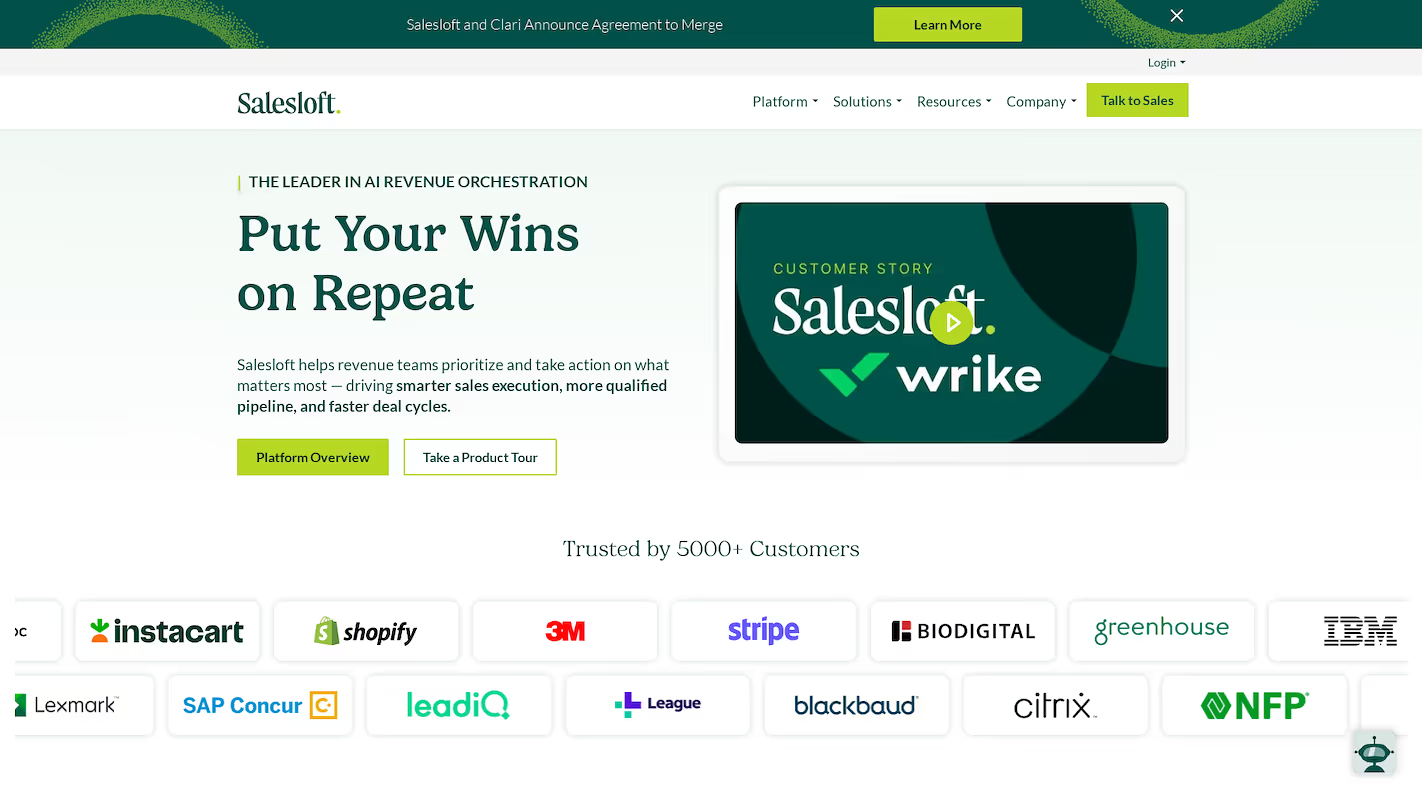
Salesloft is a Revenue Orchestration Platform that combines sales engagement, AI insights, and deal management into one workflow. It uses AI agents to identify buyer signals, prioritize actions, and automate tasks for revenue teams.
The platform supports pipeline creation, opportunity acceleration, and overall team productivity.
Salesloft's Main Features
- Prioritizes actions and recommends next steps for sales teams using an AI-powered engine called Rhythm.
- Engages website visitors with real-time, personalized conversations through AI chat agents.
- Manages the deal pipeline with AI insights that identify risk and suggest next steps.
- Generates sales forecasts by combining real-time deal data, AI, and seller input.
How Salesloft Compares to Outreach.io
Average Review score: 4.5/5 stars based on 4,145 G2 reviews.
- Salesloft uses its AI engine, Rhythm, to prioritize a seller's daily actions. This offers a more structured workflow compared to the standard task automation in Outreach.io.
- Its forecasting tools combine AI analysis with seller input for revenue prediction. This provides a different approach to the engagement-focused analytics in Outreach.io.
- The platform includes native conversation and revenue intelligence. This can reduce the need for separate tools that some teams use alongside Outreach.io.
- It provides AI-driven deal management that flags risks and suggests next steps. This adds a layer of predictive insight to pipeline management that differs from Outreach.io's engagement tracking.
Where Salesloft Falls Short of Outreach.io
- Some users find that Salesloft's integrations with certain CRMs can have occasional sync problems. Outreach.io, in comparison, often provides a more stable data flow, which reduces the need for manual data checks.
- The platform's calling and email features sometimes experience technical issues, according to user feedback. Outreach.io is often noted for its reliability, resulting in fewer dropped calls or delivery errors during campaigns.
- Its sequence customization options might feel more limited compared to Outreach.io. Users who create complex, multi-conditional sequences may find Outreach.io offers more granular control over automation rules.
Budget and Pricing Considerations
While pricing models can vary significantly between tools, we recommend checking Apollo.io's official website for the most accurate and up-to-date pricing information.
2) Apollo.io
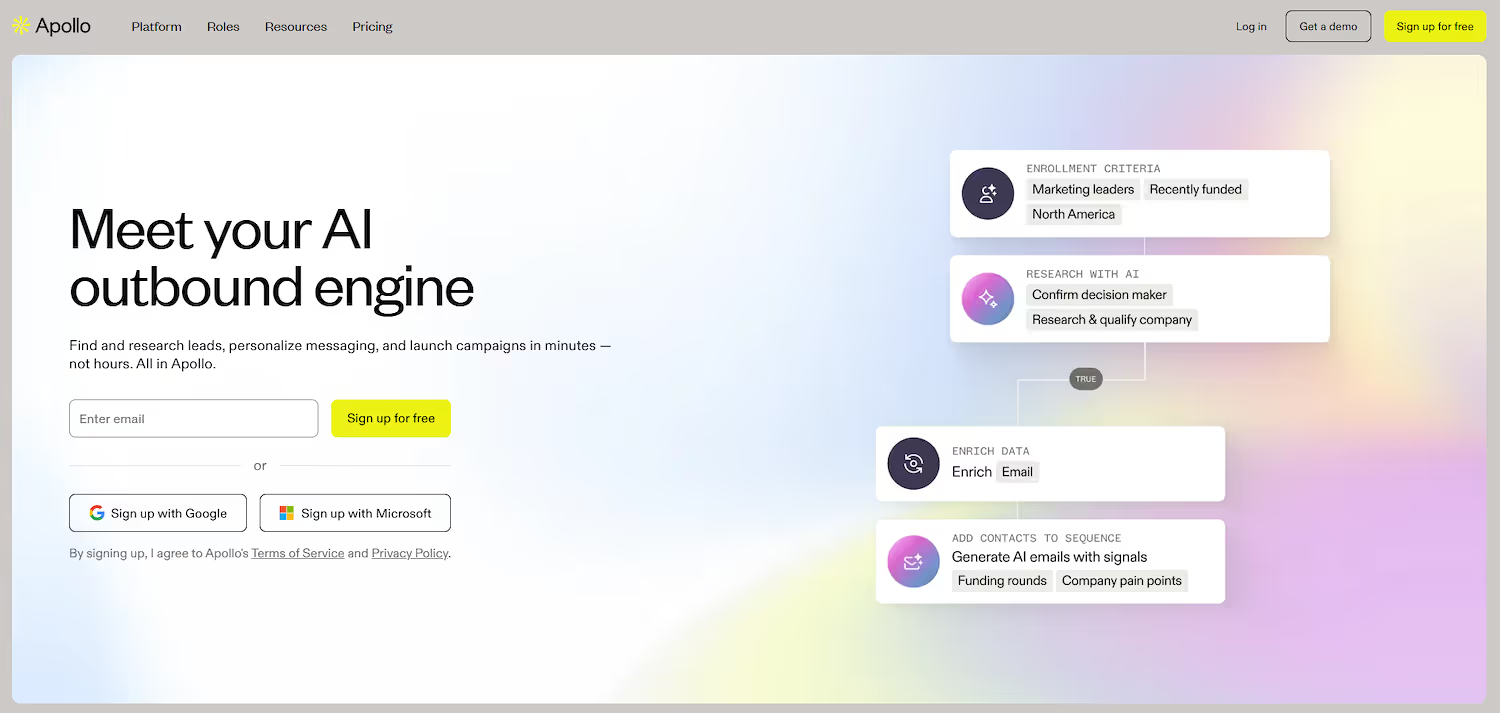
Apollo.io is a sales platform that offers a B2B database and engagement tools. It provides access to verified emails and direct-dial phone numbers for contacts.
Teams use the system to build prospect lists and run automated outreach campaigns. The platform also includes lead scoring and analytics to monitor performance and manage the sales pipeline.
Apollo.io's Main Features
- Provides access to a B2B database containing verified emails and direct-dial phone numbers.
- Allows users to build prospect lists and execute automated outreach campaigns from the same platform.
- Includes lead scoring to prioritize contacts and analytics to monitor sales pipeline performance.
How Apollo.io Compares to Outreach.io
Average Review score: 4.7/5 stars based on 8,904 G2 reviews.
- Apollo.io includes a built-in B2B database with over 210 million contacts, which means teams do not need a separate tool for prospecting as they might with Outreach.io.
- The platform combines sales intelligence and engagement tools in one place. This is different from Outreach.io, where users often rely on third-party integrations for data enrichment and lead sourcing.
- It offers a free plan and several public pricing tiers. This provides more accessible entry points for teams compared to Outreach.io's typical quote-based model.
- The tool provides native lead scoring and enrichment. This creates a more unified system for data management than using separate integrations, which is a common workflow for Outreach.io users.
Where Apollo.io Falls Short of Outreach.io
- Some users report that the contact data within Apollo.io's database can be outdated. This may lead to higher bounce rates compared to the data quality maintained through Outreach.io's dedicated CRM integrations.
- The platform's native CRM integrations might feel less comprehensive than those of Outreach.io. Teams that need deep, custom field mapping and bi-directional sync may find Outreach.io offers a more seamless data flow.
- Apollo.io provides simpler sequencing tools. In comparison, Outreach.io allows for more complex, multi-conditional automations that some large sales teams require for specific engagement workflows.
Cost-Effectiveness and Pricing
Apollo.io offers public pricing tiers, including a free plan and paid options starting at $49 per user per month. This contrasts with Outreach.io's quote-based model, offering more cost predictability for teams. For the most accurate pricing, visit Apollo.io's official website.
3) Groove

Groove is a sales engagement platform that connects with a user's CRM. It allows sales teams to run their workflow and log activities from their main system. This method keeps sales data in one place and helps with record accuracy.
The platform provides a space for sellers to manage outreach and track the results of their campaigns. This gives leaders a clear view of team performance.
Groove's Main Features
- Logs sales activities automatically within the connected CRM to ensure data accuracy.
- Manages outreach campaigns and tracks their results from a central workspace.
- Provides analytics that give sales leaders a clear view of team performance.
How Groove Compares To Outreach.io
Average Review score: 4.6/5 stars based on 193 G2 reviews.
- Groove includes a ticket management system to track customer support issues. This provides a formal way to handle inquiries, which is different from the sales task management in Outreach.io.
- It offers a shared inbox for teams to manage customer emails together. This contrasts with Outreach.io, where email tools focus on individual seller campaigns and outreach sequences.
- The platform has tools to build a customer knowledge base for self-service support. This function is distinct from the sales content and template features within Outreach.io.
- Its workflow automation centers on support tasks like ticket routing. This is different from Outreach.io, where automation drives sales sequences and prospect follow-ups.
- Groove converts incoming emails into support cases automatically. Outreach.io, by comparison, uses automation to send outbound email campaigns to prospects.
Where Groove Falls Short Of Outreach.io
- Groove offers limited customization for its automation rules, which some users find restrictive. In comparison, Outreach.io allows for complex, multi-conditional sales sequences needed for specific outreach workflows.
- Some users report that its reporting capabilities are basic and focused on support metrics. This is different from Outreach.io, which provides deep analytics on sales engagement, like open and reply rates for campaigns.
- The platform's email tools may lack advanced sales features. For example, Outreach.io includes A/B testing and dynamic templates, which are not central to Groove's support-oriented shared inbox system.
Budget and Pricing Considerations
Groove offers transparent pricing with plans starting at $15 per user per month, which contrasts with Outreach.io's quote-based model. This structure offers more cost predictability for teams. For detailed pricing, visit Groove's official website.
4) Klenty
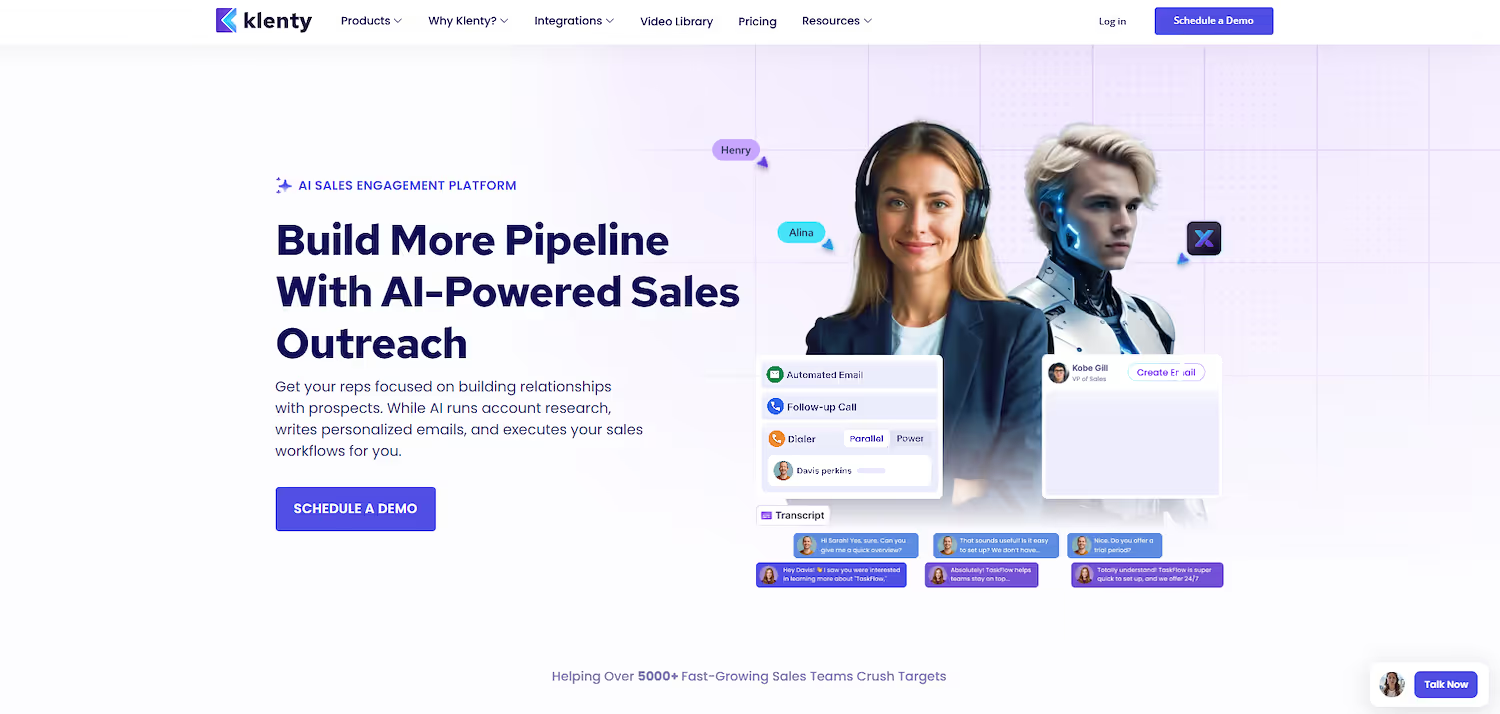
Klenty is a sales engagement platform that assists sales teams with outreach automation. Reps can send personal emails and automatic follow-ups at scale. The platform also follows prospect engagement to help sales reps identify interested leads.
Sales teams use the tool to manage sales cadences and connect with more prospects. This helps reps focus on warm contacts and avoid manual repetition.
Klenty's Main Features
- Orchestrates multi-channel outreach across email, phone, SMS, WhatsApp, and LinkedIn from a single cadence builder.
- Provides an AI writer that researches accounts and drafts personalized emails designed to land in the primary inbox.
- Includes a parallel dialer that calls up to five numbers at once and can make up to 350 calls per hour.
- Uses AI talk-track tables to offer real-time coaching that enforces a specific methodology during cold calls.
How Klenty Compares To Outreach.io
Average Review score: 4.6/5 stars based on 387 G2 reviews.
- Klenty offers public pricing plans that start at $50 per user per month. This provides more cost transparency compared to the quote-based model of Outreach.io.
- It includes a parallel dialer that calls up to five numbers at once. This feature supports high-volume call teams, a function not native to Outreach.io's standard tools.
- The platform provides real-time call coaching using AI talk-track tables. This offers live guidance during calls, a different approach from the post-call analytics in Outreach.io.
- Its cadences support multi-channel outreach across email, SMS, and WhatsApp from one place. This is a more integrated approach than Outreach.io, which often requires separate tools for some channels.
Where Klenty Falls Short Of Outreach.io
- Klenty provides reporting that covers core metrics. Outreach.io, in contrast, offers more advanced analytics, including revenue intelligence insights that some large teams require.
- Some users mention occasional data sync delays with certain CRMs. Outreach.io often has a more stable data connection, which reduces the need for manual checks in complex setups.
- The tool's LinkedIn automation capabilities are more basic. Outreach.io allows for more complex social sales sequences, which provides deeper integration for social selling strategies.
- Large organizations might find its governance features limited. Outreach.io includes more advanced user permissions and compliance controls needed for enterprise-level management.
Budget and Pricing Considerations
Klenty offers public pricing tiers starting at $50 per user per month. This contrasts with Outreach.io's quote-based model, providing more cost predictability for teams that do not require a custom enterprise package.
5) Yesware
Yesware is a sales toolkit that works inside a user's email inbox. It tracks email opens and link clicks, manages templates, and automates outreach sequences. This approach adds sales functions directly to a seller's existing email client, reducing the need to switch between applications.
Yesware's Main Features
- Tracks email opens, link clicks, and attachment views to gauge prospect interest.
- Provides a library of shareable email templates with performance analytics.
- Automates multi-touch email campaigns to follow up with prospects over time.
- Includes a meeting scheduler tool that integrates directly within the email client.
How Yesware Compares to Outreach.io
Average Review score: 4.4/5 stars based on 820 G2 reviews.
- Yesware operates directly within a user's Gmail or Outlook inbox. This differs from Outreach.io, which is a separate platform that requires users to work outside their primary inbox.
- The platform focuses heavily on email-centric features like tracking and templates. Outreach.io provides a broader, multi-channel approach that includes advanced calling and social selling tools.
- Its user interface is often considered more straightforward, making it easier for teams to adopt. Outreach.io has a steeper learning curve due to its extensive feature set and configuration options.
Where Yesware Falls Short of Outreach.io
- Yesware's automation capabilities are more focused on email drip campaigns. In comparison, Outreach.io offers more complex sequencing with conditional logic for multi-step, multi-channel workflows.
- Its reporting tools center on email engagement metrics. Outreach.io provides more advanced analytics, including revenue intelligence features that connect sales activities directly to pipeline.
- The platform has limited native support for multi-channel outreach like advanced calling or social selling. Teams that rely on these channels may find Outreach.io's integrated toolset more complete.
Budget and Pricing Considerations
Yesware offers public pricing plans, with tiers starting around $19 per user per month. This provides more cost transparency for teams compared to Outreach.io's quote-based model, which is typical for enterprise-focused solutions.
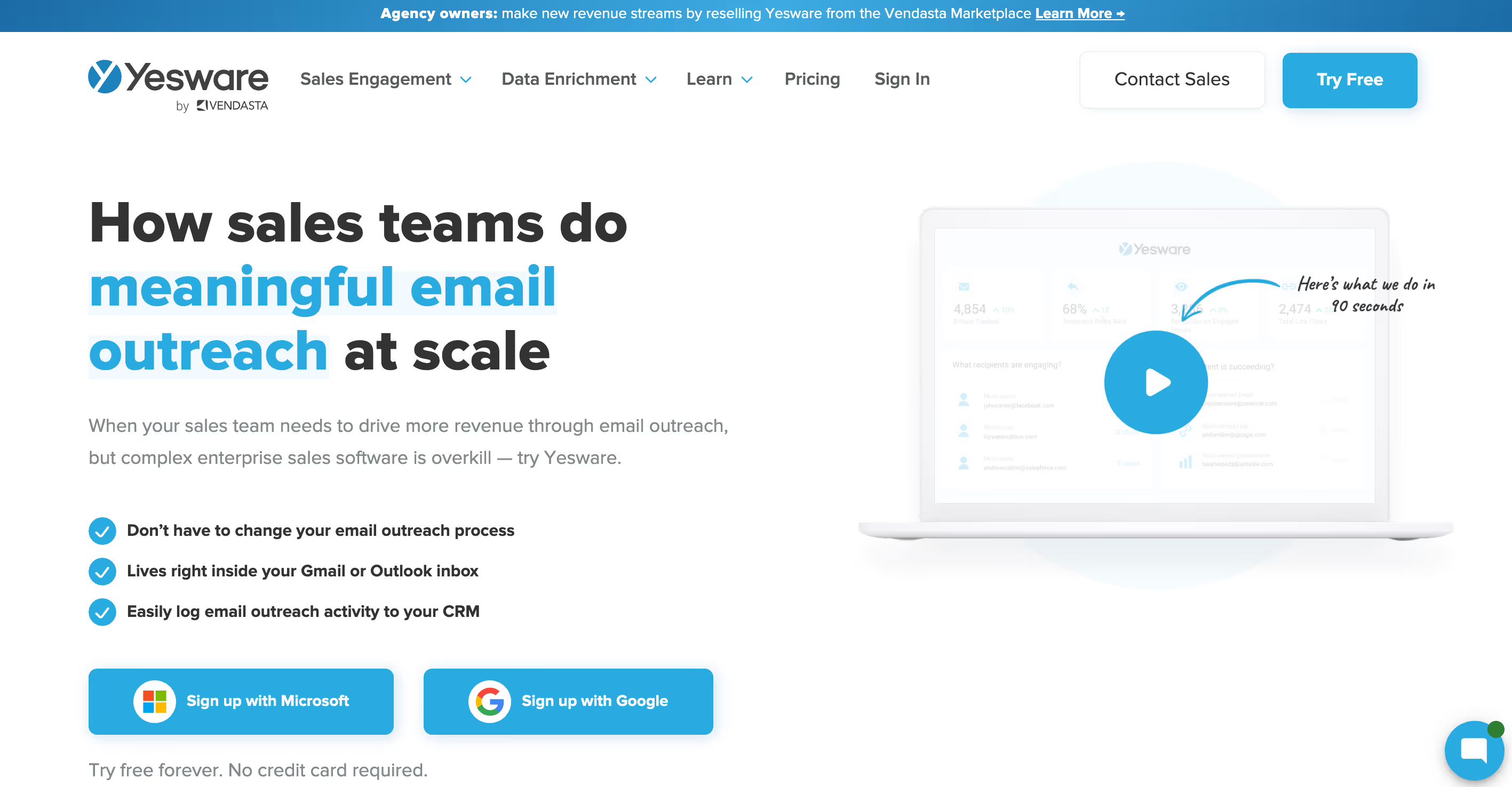
Yesware is a sales toolkit that works inside a user's email inbox. The tool tracks email opens and link clicks, manages templates, and automates outreach sequences. It adds sales functions to the email client, which removes the need for sellers to switch between applications for these tasks.
Yesware's Main Features
- Provides access to a B2B contact database with over 100 million contacts to source new leads.
- Delivers real-time notifications for email opens and clicks, along with alerts when recipients view attached files.
- Includes a meeting scheduler that integrates with Zoom and MS Teams to book appointments and populate calendars from the inbox.
- Automates multi-step outbound sequences that run directly from a user's Gmail or Outlook client.
How Yesware Compares To Outreach.io
Average Review score: 4.4/5 stars based on 819 G2 reviews.
- Yesware integrates directly into a user's Gmail or Outlook inbox, which keeps sellers in their familiar email client. This is different from Outreach.io, which is a standalone platform.
- Its user experience is often more straightforward, which can lead to quicker team adoption. In comparison, Outreach.io has a steeper learning curve due to its extensive feature set.
- The platform provides public pricing plans with clear tiers. This offers more cost predictability compared to Outreach.io's typical quote-based model.
- It focuses on core email outreach functions like tracking and templates inside the inbox. This is suitable for teams that do not need the broad, multi-channel tools found in Outreach.io.
Where Yesware Falls Short Of Outreach.io
- Yesware's automation focuses on multi-touch email campaigns. In comparison, Outreach.io builds more complex sequences with conditional logic to manage workflows across email, calls, and social media tasks.
- Its reporting tools center on email engagement metrics like open and click rates. Outreach.io provides more advanced analytics, including revenue intelligence features that connect sales activities directly to pipeline performance.
- The platform offers limited native support for channels like advanced calling or social selling. In contrast, Outreach.io provides an integrated toolset with a power dialer and LinkedIn automation, which creates a more complete system for multi-channel teams.
Budget and Pricing Considerations
Yesware provides public pricing with plans at $15, $35, and $65 per user per month for its Pro, Premium, and Enterprise tiers. This contrasts with Outreach.io's quote-based model, offering more cost predictability for teams that do not require a custom enterprise package.
Consider 11x for Your Sales Team
If your organization is exploring the use of digital workers for sales functions, 11x offers autonomous agents for prospecting and lead qualification. This approach can supplement your existing team's efforts and automate specific GTM tasks. You can learn more on their website.
With 11x, AI agents manage the sales process. Alice identifies accounts, enriches data, and handles outreach, while Julian takes calls, qualifies leads, and sets up meetings. The platform combines functions like intent data and email warmup, reducing the need for multiple tools.
Schedule a demo to see the platform's functions.
6) Reply.io
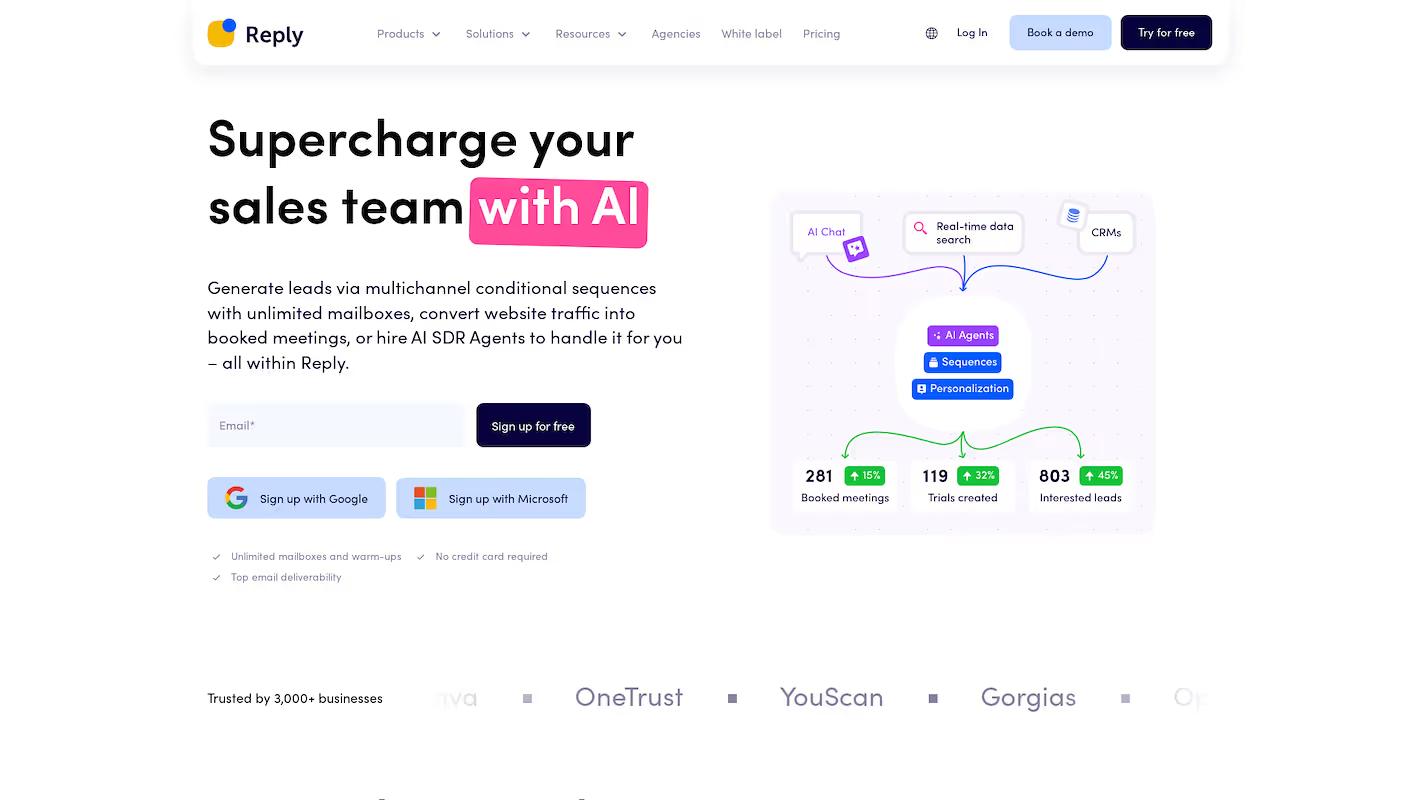
Reply.io is a sales engagement platform for multi-channel outreach. It helps sales teams connect with prospects across email, calls, LinkedIn, and WhatsApp. The system automates sequences to contact leads at scale.
Teams use it to find contacts, execute campaigns, and book meetings. The platform centralizes communication channels for sales development representatives.
Reply.io's Main Features
- Offers an autonomous AI agent, Jason AI, that handles prospecting, generates personalized messages, manages replies, and books meetings.
- Allows users to build multichannel sequences that combine email, LinkedIn, calls, SMS, and WhatsApp with any Zapier step in a single flow.
- Includes a deliverability suite with over 30 tools, such as an email health checker and unlimited mailbox warm-up, to help emails land in the primary inbox.
- Provides AI tools that generate entire outbound sequences from a prompt and use paragraph-level variables to rewrite each email uniquely.
How Reply.io Compares To Outreach.io
Average Review score: 4.6/5 stars based on 1,458 G2 reviews.
- Reply.io provides an autonomous AI agent to handle prospecting, messaging, and meeting booking. This differs from Outreach.io, where AI typically assists seller actions rather than managing the full process.
- It allows users to add any Zapier step into a multi-channel sequence, which includes email, SMS, and WhatsApp. This offers more channel flexibility within a single workflow compared to Outreach.io's native integrations.
- The platform includes a dedicated email deliverability suite with health checks and unlimited warm-ups. This provides a more focused toolset for inbox placement than the standard deliverability features in Outreach.io.
- This tool offers an AI chat for websites that uses video avatars to engage visitors and book meetings. This is a distinct feature for lead capture not found in Outreach.io's core platform.
Where Reply.io Falls Short Of Outreach.io
- Reply.io offers foundational reporting on campaign metrics. In comparison, Outreach.io provides more advanced revenue intelligence that connects sales activities directly to pipeline performance.
- Some users note that its native CRM integrations can be less comprehensive. Outreach.io often provides a more stable data flow with deeper custom field mapping for complex setups.
- The platform's governance features may be insufficient for large enterprises. In contrast, Outreach.io includes more advanced user permissions and compliance controls needed for large-scale team management.
Budget and Pricing Considerations
Reply.io offers public pricing, including a free plan and paid tiers starting at $49 per user per month. This transparent model provides more cost predictability than Outreach.io's quote-based system, which is common for custom enterprise solutions.
7) Mailshake
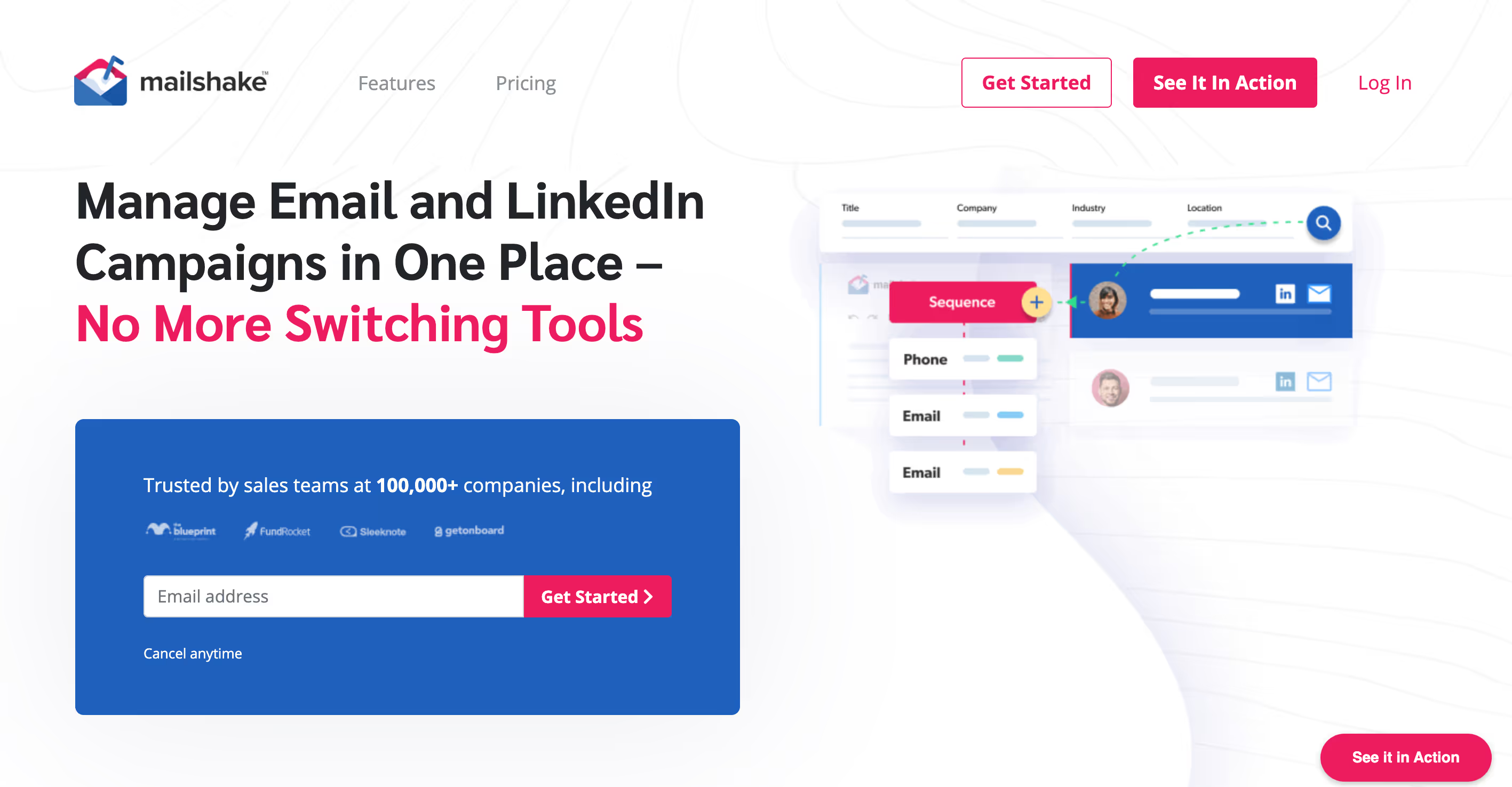
Mailshake is a sales engagement platform for cold email outreach. It helps sales teams automate personalized campaigns and follow-up sequences at scale. The tool is designed to connect with prospects through direct email communication.
Common use cases include sales prospect development, public relations outreach, and content promotion. Users can manage their campaigns and track results within the platform.
Mailshake's Main Features
- Includes a built-in data finder to search for and purchase verified prospect email addresses by role, location, or company.
- Provides an AI email writer, SHAKEspeare, that auto-generates and spins copy, subject lines, and A/B test variants.
- Offers an email deliverability suite with a domain setup assistant, free email warm-up, list cleaning, and a copy analyzer.
- Uses a lead catcher to prioritize highly engaged prospects into a dedicated queue for quick action by the sales team.
How Mailshake Compares To Outreach.io
Average Review score: 4.7/5 stars based on 326 G2 reviews.
- Mailshake includes a built-in data finder to source and purchase prospect emails. This is different from Outreach.io, where users often need a separate data provider for lead generation.
- Its AI email writer, SHAKEspeare, generates copy and A/B test variations automatically. This provides a more focused content creation tool compared to the broader AI assistance in Outreach.io.
- The platform provides a dedicated email deliverability suite with free warm-up and list cleaning. This offers a more specialized set of tools for inbox placement than the standard features in Outreach.io.
- Mailshake uses a lead catcher to create a dedicated queue for highly engaged prospects. This offers a simple way to prioritize leads, which differs from the more complex, multi-channel lead scoring in Outreach.io.
Where Mailshake Falls Short Of Outreach.io
- Mailshake focuses primarily on email outreach. In comparison, Outreach.io provides a more integrated system with native tools for advanced calling and social selling tasks.
- Its automation capabilities are more focused on email sequences. Outreach.io allows for more complex workflows with conditional logic that can manage tasks across multiple channels like calls and social media.
- The platform's reporting provides key email engagement metrics. In contrast, Outreach.io offers more advanced analytics, including revenue intelligence features that connect sales activities directly to pipeline performance.
- Some users report that its CRM integrations can be less comprehensive. Outreach.io often provides deeper, more stable data synchronization, which can be a key requirement for large teams.
Budget and Pricing Considerations
Mailshake offers public pricing plans at $29, $59, and $99 per user per month. This transparent model provides more cost predictability than Outreach.io's quote-based system.
8) Mixmax
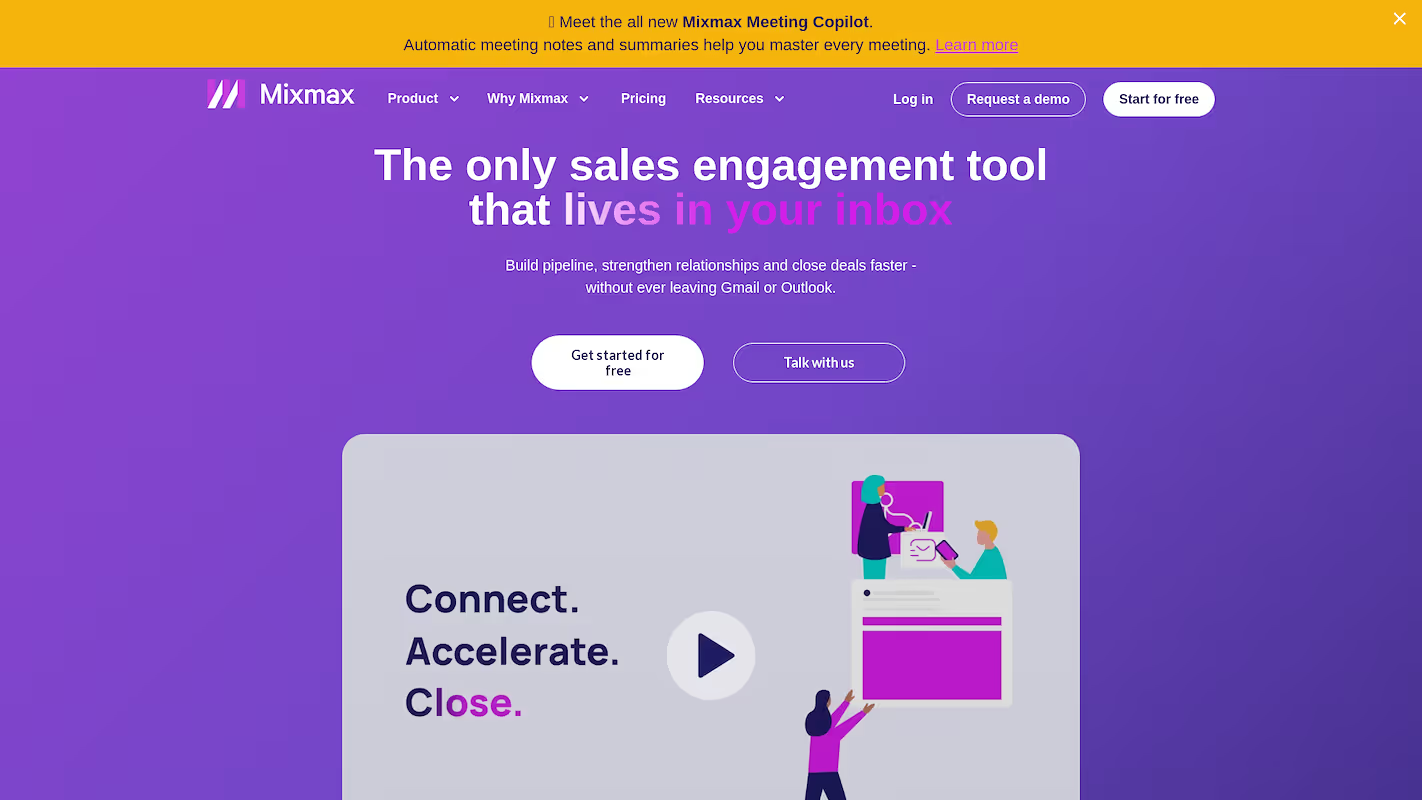
Mixmax is a sales engagement tool that works within a user's email client. It adds sales functions directly to the inbox, which lets teams manage outreach without a separate application.
Sales teams use the platform to automate email sequences, track engagement, and schedule meetings. This approach connects sales activities to the place where sellers spend most of their time.
Mixmax's Main Features
- Tracks email opens, link activity, and attachment views to measure prospect engagement.
- Manages integrated workflows and schedules emails directly from the user's inbox.
- Provides analytics on workflow performance and reports on email engagement.
- Integrates with CRMs to automate task management and data entry.
How Mixmax Compares To Outreach.io
Average Review score: 4.6/5 stars based on 1,433 G2 reviews.
- Mixmax operates directly within a user's Gmail or Outlook inbox. This is different from Outreach.io, which is a standalone platform that requires users to work outside their primary email client.
- It allows users to add interactive elements like polls and surveys directly into emails. This provides a different way to engage prospects compared to the standard email templates in Outreach.io.
- The tool has a more straightforward interface, which allows for quicker team adoption. In comparison, Outreach.io often has a steeper learning curve due to its extensive feature set.
- Mixmax offers public pricing plans with clear tiers. This provides more cost predictability for teams, unlike Outreach.io's quote-based model.
Where Mixmax Falls Short Of Outreach.io
- Mixmax's automation capabilities focus on email-centric sequences. In comparison, Outreach.io allows for more complex workflows with conditional logic that can manage tasks across multiple channels, including calls and social media.
- The tool's reporting provides insights into email engagement metrics. Outreach.io, on the other hand, offers more advanced analytics with revenue intelligence features that connect sales activities directly to pipeline performance.
- Some users find its native CRM integrations can be less comprehensive for complex needs. Outreach.io often provides deeper data synchronization with more extensive custom field mapping, which can be important for large teams.
- Its platform governance may not be sufficient for some large organizations. In contrast, Outreach.io includes more advanced user permissions and compliance controls designed for enterprise-level management.
Budget and Pricing Considerations
Mixmax offers public pricing plans starting at $49 per user per month. This transparent model provides more cost predictability than Outreach.io's quote-based system, which is common for custom enterprise solutions.
9) HubSpot Sales Hub
HubSpot Sales Hub is a sales software platform built on the HubSpot CRM. It combines sales engagement, reporting, and deal management tools into a single system. This approach provides teams with a unified platform for their sales activities.
HubSpot Sales Hub's Main Features
- Automates email outreach with personalized sequences and follow-ups.
- Tracks email opens and link clicks to monitor prospect engagement in real time.
- Includes a meeting scheduler that syncs with calendars to simplify appointment booking.
- Provides sales analytics and reporting tools to track performance against quotas.
How HubSpot Sales Hub Compares To Outreach.io
Average Review score: 4.5/5 stars based on 12,181 G2 reviews.
- HubSpot Sales Hub is an all-in-one platform with a native CRM. This is different from Outreach.io, which is a specialized tool that integrates with external CRMs like Salesforce.
- Its tight integration with the HubSpot CRM can reduce data sync issues. This contrasts with Outreach.io, where teams manage the connection between two separate systems.
- The platform is often considered more user-friendly, especially for teams already using other HubSpot products. Outreach.io may have a steeper learning curve due to its specialized feature set.
Where HubSpot Sales Hub Falls Short Of Outreach.io
- HubSpot's sales automation may be less advanced for complex needs. Outreach.io often provides more granular control over multi-step, conditional sequences for high-volume outbound teams.
- Some large enterprises find Outreach.io's features are more tailored to their specific workflows. HubSpot is often a strong fit for small to mid-sized businesses.
- While it integrates with Salesforce, Outreach.io's connection is often deeper. This can be a factor for teams heavily invested in the Salesforce ecosystem.
Budget and Pricing Considerations
HubSpot Sales Hub offers public pricing with multiple tiers, including a free version. This provides more cost transparency compared to Outreach.io's quote-based model, which is common for enterprise-focused solutions.
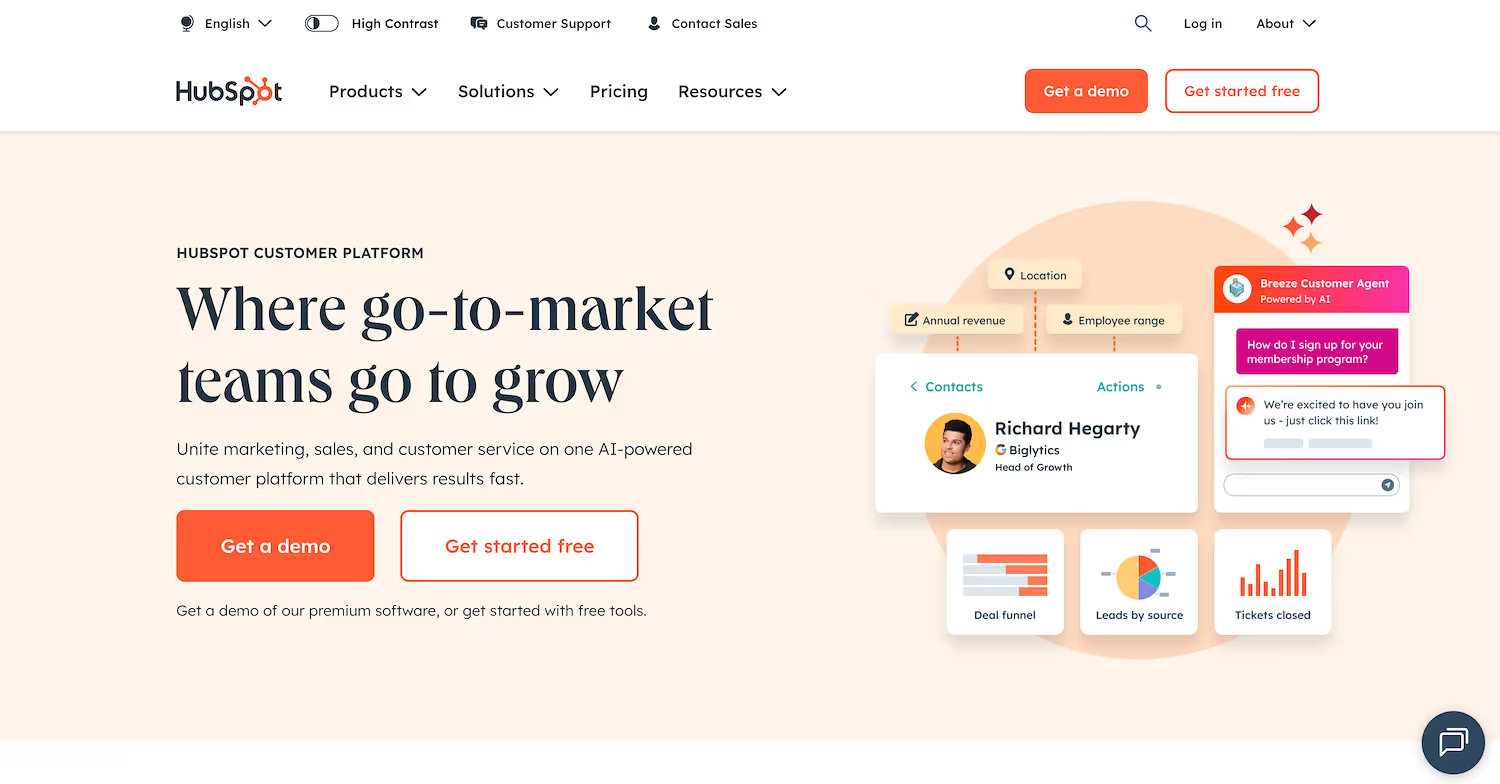
HubSpot Sales Hub is a sales software platform built on the HubSpot CRM. It combines sales engagement tools, sales analytics, and deal management functions into one system. This approach gives teams a single platform for sales activities like email automation and performance analysis.
HubSpot Sales Hub's Main Features
- Automates marketing efforts and manages campaigns.
- Includes customer support functions to handle service inquiries.
- Provides case management to track and resolve customer issues.
- Offers social collaboration features for internal teams.
How HubSpot Sales Hub Compares To Outreach.io
Average Review score: 4.4/5 stars based on 12,407 G2 reviews.
- HubSpot Sales Hub includes a native CRM, which provides a single system for all sales data. This can reduce data sync issues that sometimes occur when connecting Outreach.io to an external CRM.
- It combines sales, marketing, and customer support tools on one platform. This is different from Outreach.io, which focuses mainly on sales engagement and often requires separate tools for marketing or support functions.
- The platform is often considered more user-friendly, especially for teams already using other HubSpot products. In comparison, Outreach.io can have a steeper learning curve due to its specialized feature set for outbound sales.
- This tool includes case management features to track and resolve customer issues. This provides a native customer support function that is not a core part of Outreach.io's sales-focused platform.
Where HubSpot Sales Hub Falls Short Of Outreach.io
- HubSpot Sales Hub provides simpler sales automation. Outreach.io, in comparison, offers more granular control over sequences with complex conditional logic, a feature some large outbound teams need for specific workflows.
- The tool's native calling features are more basic. In contrast, Outreach.io includes a power dialer and advanced call coaching tools, which provides a more complete system for teams that make a high volume of calls.
- Some users find its governance features are less suited for large organizations. Outreach.io, by comparison, includes more advanced user permissions and compliance controls that enterprise teams often require for management.
Budget and Pricing Considerations
HubSpot Sales Hub provides public pricing plans at $20 (Starter), $100 (Professional), and $150 (Enterprise) per seat monthly. This transparent model offers more cost predictability than Outreach.io's quote-based system, which is common for custom enterprise solutions.
10) Outplay

Outplay is a sales engagement platform for multi-channel prospect contact. It automates sales sequences across email, phone, SMS, and social media. Teams use it for outbound sales, inbound conversion, and account-based sales. The system tracks interactions to provide data for sales teams.
Outplay's Main Features
- Engages prospects across multiple channels from a single platform.
- Includes a built-in prospecting tool with a database for sourcing new leads.
- Provides AI-powered conversational intelligence for insights from sales calls.
- Offers a power dialing feature to increase the volume of outbound calls.
How Outplay Compares To Outreach.io
Average Review score: 4.5/5 stars based on 269 G2 reviews.
- Outplay includes a built-in prospecting database to source new leads. This is different from Outreach.io, where teams often use a separate data provider for lead generation.
- It provides AI-powered conversational intelligence to analyze sales calls. This offers a specific type of insight, while Outreach.io focuses more on broader engagement analytics across channels.
- The platform offers public pricing plans, which gives teams more cost predictability. This contrasts with Outreach.io's typical quote-based model that requires a custom sales process.
- This tool features a native power dialer to help increase outbound call volume. This provides a built-in solution for high-volume calling as part of its all-in-one system.
Where Outplay Falls Short Of Outreach.io
- Outplay provides foundational sales analytics. In comparison, Outreach.io offers more advanced revenue intelligence features that connect sales activities directly to pipeline performance, which some large teams may need.
- Some users report that its CRM integrations can have occasional data sync issues. Outreach.io, by comparison, often provides a more stable data flow with deeper custom field mapping for complex setups.
- The platform's governance features might be less comprehensive for large organizations. In contrast, Outreach.io includes more advanced user permissions and compliance controls needed for enterprise-level management.
Cost and Pricing Comparison
Outplay offers public pricing, with user reviews mentioning a cost of $99 per user per month. This model provides more cost predictability compared to Outreach.io's quote-based system, which lacks public pricing and requires a custom sales process.
Which One Should You Go With?
Choosing an Outreach.io alternative depends on your team's specific needs, budget, and existing tech stack. This guide reviewed the top options to help you make an informed decision based on features and user feedback.
If your organization is exploring the use of digital workers for sales functions, 11x offers autonomous agents for prospecting and lead qualification. This approach can supplement your team's efforts and automate specific GTM tasks.




